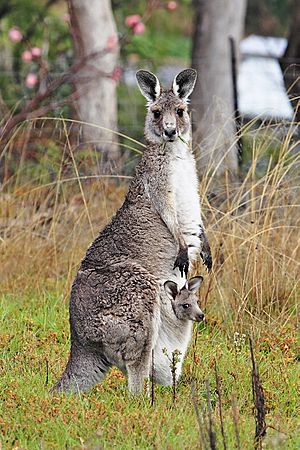Bipedalism facts for kids
Bipedalism is a way of moving around on the ground. It means using only two legs to get around. Animals that move this way use their back legs. Some animals always move on two legs; they are called habitual bipeds. Others can choose to move on two or four legs; they are called optional bipeds.


Contents
Why do animals walk on two legs?
Moving on two legs can be very helpful for certain animals. Here are some reasons why:
- Better View: Standing tall helps animals see further. They can spot dangers or find food more easily.
- Free Hands (or Paws!): When the back legs are busy walking, the front legs (or arms) are free! Animals can use them to grab things, fly (like birds), dig, fight, or even hide.
- Reaching Food: Being upright lets animals reach higher branches for food.
Even though animals like the ostrich and red kangaroo can run up to 70 kilometers per hour (about 43 miles per hour) on two legs, and a cheetah can run over 100 kilometers per hour (about 62 miles per hour) on four, walking on two legs has its own benefits. For humans, moving on two legs over long distances has helped us travel far, even outrunning many other animals over time.
How do bipeds move?
There are a few main ways that animals move when they are bipedal:
- Standing: Just staying still on two legs. Most bipeds need to keep adjusting their balance to stay upright.
- Walking: Moving one foot in front of the other. At least one foot is always on the ground.
- Running: Moving one foot in front of the other, but with short moments when both feet are off the ground.
- Jumping/Hopping: Moving by taking a series of jumps, with both feet leaving the ground at the same time.
Which animals are bipeds?
Most animals that live on land walk on four legs. Only a few groups of animals move on two legs.
Birds
All birds walk on two legs when they are on the ground. They got this ability from their dinosaur ancestors.
Reptiles
Many types of lizards can stand and run on two legs when they need to move very fast. This includes the spiny-tailed iguana, which is one of the fastest lizards in the world. The very first known animal to walk on two legs was an early reptile called Eudibamus, which lived about 290 million years ago.
Dinosaurs
Many dinosaurs were bipeds. Scientists believe that all dinosaurs came from an ancestor that walked on two legs. Some dinosaurs, like the iguanodon, also developed bipedal movement.
Mammals
Moving on two legs is less common for mammals, as most walk on four. But some mammals have developed this ability on their own:
- Humans: We are the most well-known bipeds. Our ability to walk upright has been studied a lot.
- Kangaroos and their relatives: Animals like kangaroos, wallabies, and kangaroo rats hop on two legs.
- Pangolins: The giant pangolin can walk on two legs.
- Bears: Most bears walk on four legs, but sometimes they stand or walk on two. There was even a famous black bear named Pedals who often walked on his back legs because of injuries to his front paws.
Primates
Many primates can stand on their back legs without support. This is unusual because most other bipeds walk with their backs closer to the ground, using a long tail for balance. Primates like chimpanzees, bonobos, and gibbons can walk on two legs. Sifakas, a type of lemur, move by hopping sideways on their back legs.
The ability for humans to walk on two legs started to develop in our ancestors about four to seven million years ago. One idea is that it helped early humans carry food to share with their groups.
Muscles and breathing
Walking on two legs needs very strong leg muscles, especially in the thighs. Think about a chicken's strong legs compared to its small wings! In humans, the muscles in our thighs (like the quadriceps and hamstrings) are much bigger than our arm muscles because they are so important for bipedal movement.
When a bipedal animal runs, it can breathe without its breathing being directly tied to each step. Humans usually take a breath every other step when running at a steady pace.
Bipedal robots
For a long time, building robots that could walk on two legs was very hard. Most robots used wheels, tracks, or many legs. But now, with powerful and small computers, two-legged robots are becoming more common. Some famous bipedal robots include ASIMO, HUBO, and QRIO. Scientists are learning from how humans and animals walk to make these robots move more smoothly and use less power.
Images for kids
-
An ostrich, one of the fastest animals that walks on two legs
See also
 In Spanish: Bipedestación para niños
In Spanish: Bipedestación para niños



